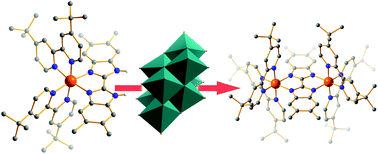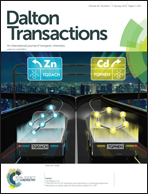Cluster-controlled dimerisation in supramolecular ruthenium photosensitizer–polyoxometalate systems†
Abstract
A supramolecular reaction system is reported where a labile molecular metal oxide cluster enables the unprecedented dimerisation of ruthenium photosensitizers [Ru(L)2(tmbiH2)]2+ (L = 4,4′-di-tert-butyl-2,2′-bipyridine (1a) or 2,2′-bipyridine (1b); tmbiH2 = 5,5′,6,6′-tetramethyl-2,2′-bibenzimidazole). In the presence of [Mo8O26]4− clusters (2) the dimerisation is triggered by the in situ conversion of [Mo8O26]4− to [Mo6O19]2− which results in the release of hydroxide ions. Simultaneous deprotonation of the pH-sensitive tmbiH2-ligands starts the dimerisation, resulting in the formation of the dinuclear complex [(Ru(L)2)2(tmbi)]2+ (L = 4,4′-di-tert-butyl-2,2′-bipyridine (3) or 2,2′-bipyridine (4)). The dimerisation reaction can be suppressed when 2 is replaced by a stable polyoxomolybdate cluster, [Mo5O15(PhPO3)2]4− (5) and the reaction between 1a and 5 leads to the formation of hydrogen-bonded supramolecular aggregates 6. The solution and solid-state interactions in these systems were investigated using a range of spectroscopic and crystallographic techniques and compounds 3, 4 and 6 were characterized using single-crystal XRD.


 Please wait while we load your content...
Please wait while we load your content...